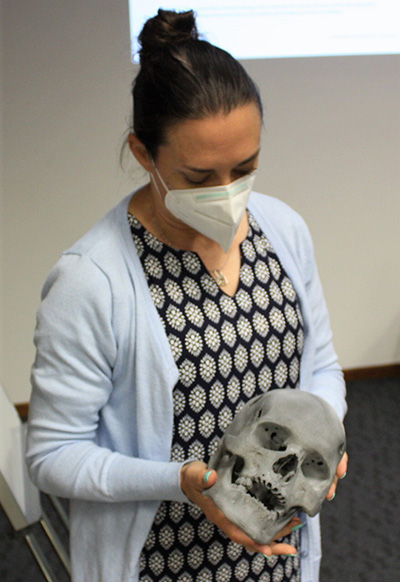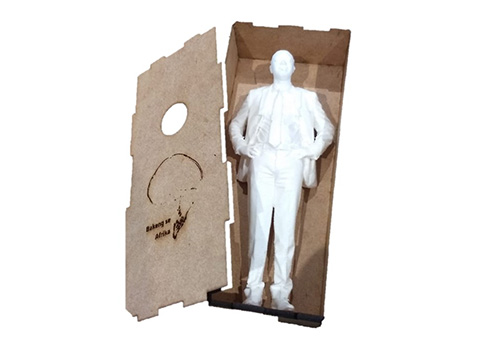Like other forensic facilities around the world, South Africa’s University of Pretoria (UP)’s Forensic Anthropology Research Centre (FARC) is skilled at using 3D printing technology to assist forensic science experts in missing person cases and develop suspect leads in violent crimes. FARC’s modern forensic anthropology laboratory, equipped for processing and analyzing human remains, conducts approximately 100 skeletal analyses per year for the South African Police Service and the Forensic Pathology Services. Drawn by the convenience of using 3D printing in forensic reconstructions, FARC researchers have begun to outline many potential applications that can benefit from 3D replicas, even outside their department.
In March 2022, FARC announced its decision to set up a 3D printing facility for other divisions of UP’s Faculty of Health Sciences. And with over 600 academic staff members and thousands of students, there is a great demand for 3D printing replicas of bones and organs, such as brains, hearts, and livers, which can improve healthcare, research, and student training.
FARC Director and Professor of Biological Anthropology Ericka L’Abbé has plenty of experience with 3D printing. She is one of the brains behind the European Union-funded Bakeng se Afrika project, a digital skeletal repository that relies on global advances in 3D research to identify unknown persons in forensic anthropology and will be particularly useful for advances in medicine and education in South African Universities. L’Abbé and her team are accustomed to using different scanning modalities to create high-quality 3D renderings of bones that can be converted into meshes and 3D printed.

University of Pretoria Professor Ericka L’Abbé holds a 3D print of a trauma skull from the Bakeng se Afrika trauma workshop. Image courtesy of the University of Pretoria.
Eager to share her knowledge, L’Abbé said that the benefits of 3D printing anatomical models and more would particularly benefit her colleagues in orthopedic surgery and prosthodontics (one of the branches of dentistry that deals with the replacement of missing teeth). FARC postdoctoral researcher Alison Ridel is already working towards that goal and is collaborating with prosthodontic medical expert Alwyn Fortuin on digital methods to reconstruct a face before and after tumor resection.
Ridel will assist the surgeon with processing the patient’s 3D cone-beam computed tomography (CT) data before and after surgery to provide 3D prints of the face so that Fortuin can visualize the surgical procedure and explain it to the patient.
“In the case of body structures, it is much easier to visualize structures and make informed decisions based on a physical object than a flat image. By adding the third dimension for the purposes of teaching and the treatment of patients, we can harness valuable additional information to enhance outcomes,” explained L’Abbé.
The teams can also use a CT scan to make a 3D mesh of a patient’s soft or hard tissue, which can be 3D printed and used by the surgeon during pre-operative planning.

A digital reconstruction of a micro-XCT scan of a mandible. Image courtesy of the University of Pretoria.
For the facility to operate as planned, L’Abbé hopes to attract students who can handle 3D imaging processing and 3D printing for medical doctors. In addition, the expert is eager to engage transdisciplinary and collaborative approaches across various faculties and disciplines to realize the full benefits of advanced imaging technology within higher education institutions and the workplace. Moreover, by encouraging students to learn 3D imaging processing and printing, she will help increase the workplace readiness of UP’s students.
Such a 3D printing expert at UP is Marius Loots. The expert is part of L’Abbé’s team at FARC, and as first technical operator, he handles everything relating to 3D printing software and hardware. Used to leveraging the capabilities of 3D technologies like fused filament fabrication, stereolithography, and selective laser sintering, Loots said that the medical departments would highly benefit from the technology. For example, students at UP could 3D print a standard set of teeth to study dental morphology.
To showcase the technology available at the facility, the FARC team performed a 3D surface scan on UP Vice-Chancellor and Principal Tawana Kupe, which was then 3D printed.
“When people start to see a 3D mesh or print of Professor Kupe or Professor Tiaan de Jager, Dean of the Faculty of Health Sciences, they start thinking of applications of this technology in their own disciplines,” L’Abbé said. “A 3D printed person makes the technology real and relatable to everyone, regardless of the discipline.”

A 3D printed model of University of Pretoria Professor Kupe made through collaboration with the Forensic Anthropology Research Centre and 3D scanning and printing teams. Image courtesy of the University of Pretoria.
L’Abbé, whose work stems from Erasmus+ grants financed by the Education, Audiovisual, and Cultural Executive Agency (EACEA) of the European Commission, is eager to see what the “future-focused” faculty at UP is capable of doing with 3D printing to improve people’s lives. Up until now, UP is known for housing a collection of various types of trauma on bone, like gunshot wounds and blunt force trauma 3D prints, which help save the original skeletal element from destruction by use. However, as more uses for 3D printing continue inundating the healthcare industry, it is clear that the technology has disrupted this sector worldwide and is already helping improve the lives of patients and medical professionals.
Subscribe to Our Email Newsletter
Stay up-to-date on all the latest news from the 3D printing industry and receive information and offers from third party vendors.
You May Also Like
DyeMansion Debuts Polymer Post-Processing Solutions at Formnext 2024
DyeMansion is shaking up post-processing workflows with three new solutions unveiled at Formnext 2024. Under the motto It Just WorX, the company introduced the Powershot X for blasting and surfacing,...
Nano Dimension Expands Micro-Manufacturing with Exa 250vx 3D Printer
As it continues to push for the acquisitions of Desktop Metal and Markforged, Nano Dimension has introduced a new micro-3D printing system at Formnext. Adding to the Fabrica Tera and...
3D Systems Pushes New Tech and Partnerships at Formnext
As one of the pioneering companies in additive manufacturing (AM), 3D Systems remains a key player to watch at Formnext 2024, where it is showcasing major partnerships, innovative technologies, and...
Formnext Day Three: Rock & Zoll
The biggest news on day three was, of course, the reactions to the band at the exhibitor’s party. The soirée was well attended, with the crowd rocking on until early...



































